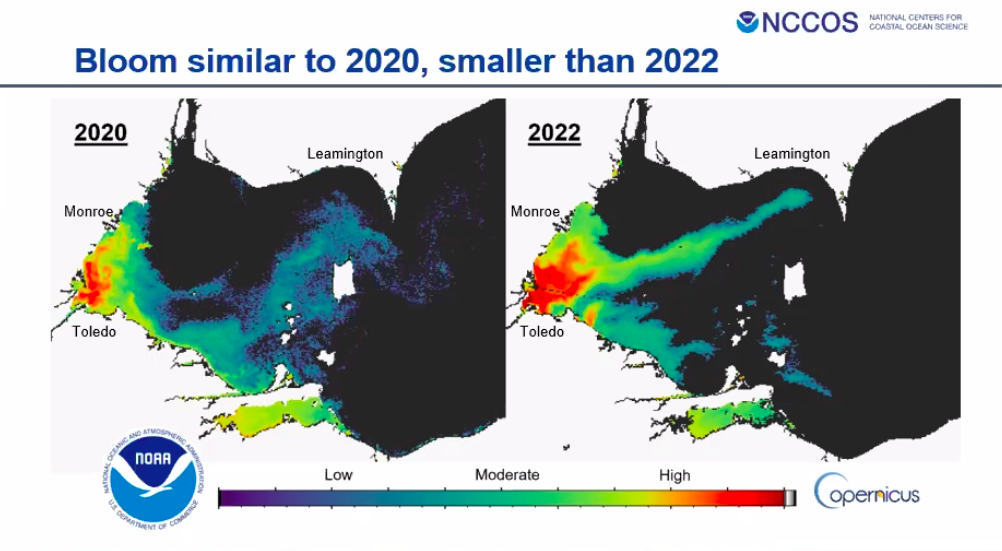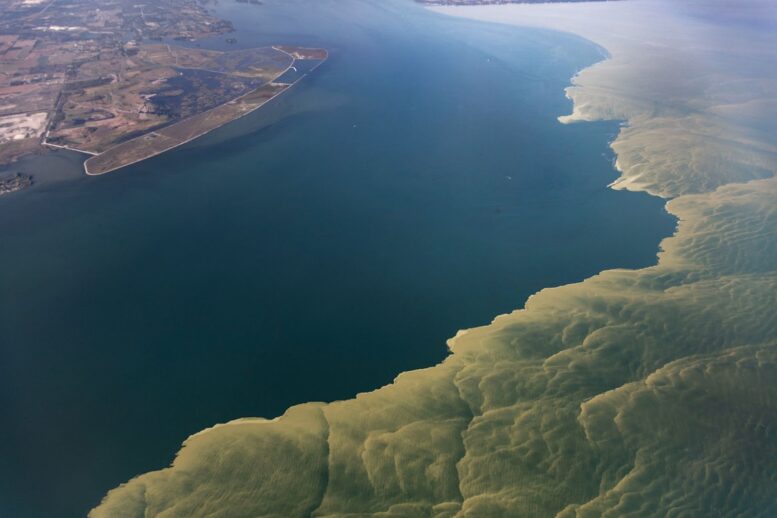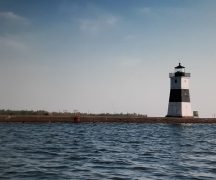By DAVID DUPONT
BG Independent News
Researchers who study Lake Erie are forecasting that western Lake Erie will experience a smaller-than-average harmful algal bloom that would be less severe than last summer.
The forecast announced by the National Oceanic and Atmospheric Administration this morning (6-29-23) is for a bloom of 3 in intensity, with a range of 2-4.5. Though 10 as set as the worst number in 2011, it was exceeded in 2015 when the bloom was 10.5.

Last year’s was 6.8. Rick Stumpf, of NOAA, noted in delivering the forecast that the extend of the bloom was underestimated. The early forecast was for a level 5 bloom.
Conditions vary from season to season with scientists noting shifting patterns.
The bloom typically starts forming in mid-July, but Stumpf said that the bloom is already blossoming in late June.
The blooms are also tending to last longer, and that may be more significant than the peak intensity. If a bloom reaches peak intensity that only lasts a few days, that’s less of a problem than a lower peak that persists for several weeks, as they have in recent years.
Stumpf said it is important to provide this early forecast so people who rely on the lake can get a sense of what’s in store, but there will be an update later in the season.
“The harmful algal bloom forecast translates the latest science into actionable information for our partners and the public,” said NOAA Chief Scientist Sarah Kapnick, Ph.D. “As we move into the summer season, having accurate, reliable information about this year’s expected bloom will help protect public health and economic activity for communities along Lake Erie.”
The most important factor is how much phosphorus is flowing into the lake particularly from the 4-million-acre Maumee River watershed.
Laura Johnson, director of the National Center for Water Quality Research at Heidelberg University, said that because of a dry spring less phosphorus has found its way to the lake. More than 80 percent came in March, which was a wet month. May, she said, was the driest May since 1934, during the Dust Bowl, and April, May, and June combined haven’t been this dry since the drought of 2012.
Still the amount of phosphorus is above the targeted amount, she said.
That phosphorus comes from fertilizers applied late last year, or so-called legacy phosphorus, that has been in the soil for a number of years.

However, Stumpf noted that more attention is being paid to the impact of rains later in the season, particularly July when the algae blooms are growing.
Heavy rains in July could make for a moderately severe bloom, Stumpf said.
According to the NOAA press release announcing the forecast:
“Lake Erie HABs consisting of cyanobacteria, or blue-green algae, are capable of producing microcystin, a known liver toxin which poses a risk to human and wildlife health. Such blooms may force cities and local governments to treat drinking water, close beaches and can harm vital local economies by preventing people from fishing, swimming, boating, and visiting the shoreline.
“The size of a bloom isn’t necessarily an indication of how toxic it is. For example, the toxins in a large bloom may not be as concentrated as in a smaller bloom. Each algal bloom is unique in terms of size, toxicity and ultimately its impact on local communities.”
Stumpf said that the concentrated scum that forms along shorelines is toxic and kills several pets every year. The formation of that scum and its location depends on wind currents which can cause the bloom to concentrate.
If there is a bloom, and it develops scum it will be in Maumee Bay, he said.
Christopher Winslow, the director of Ohio Sea Grant and Stone Laboratory, offered a positive assessment for the efforts being taken through H2Ohio to address the issue. Those include different agricultural practices, water treatment, use of wetlands, as well as state laws forbidding the application of fertilizer, both manure and commercial fertilizer, under certain conditions.
While some practices may work under conditions many may work on one field but not another. “There is no silver bullet,” he said.
The Ohio Environmental Council said that despite the forecast for a less severe bloom, more needs to be done.
A statement attributed to Melanie Houston, the council’s managing director of water policy, asserted:
“Regardless of severity, any harmful algal bloom threatens the health of Ohioans and their environment because of the algae’s toxicity to humans and wildlife. Every year, beaches close from toxic algae that contaminates Lake Erie and Ohio’s inland lakes, and we are yet to see measurable improvements. Harmful algal blooms restrict recreation and tourism, harming the local economy and Ohioans’ ability to enjoy Lake Erie while threatening the safety of Toledoans’ drinking water.
“Today’s forecast comes on the heels of the Sackett vs. EPA decision that makes Ohio’s wetlands — a natural solution to filter nutrient runoff — even more vulnerable to degradation from development. In order to match the scale of the problem and restore our Great Lake Erie, Ohio needs bolder investments, stronger wetland protections and more aggressive pollution reduction strategies from our state leaders.”





